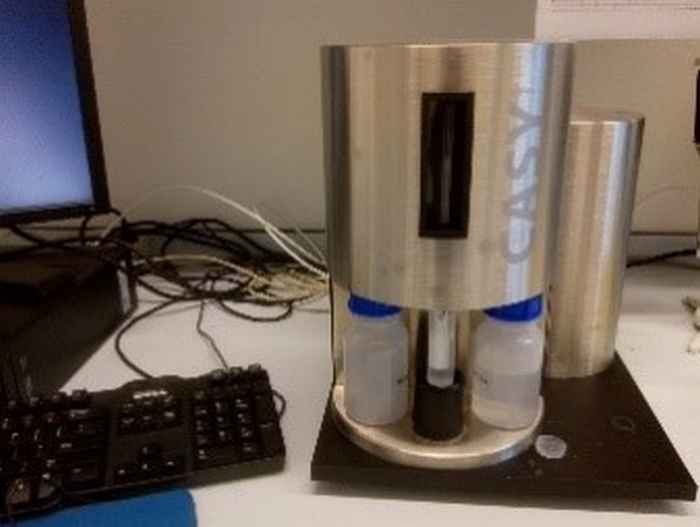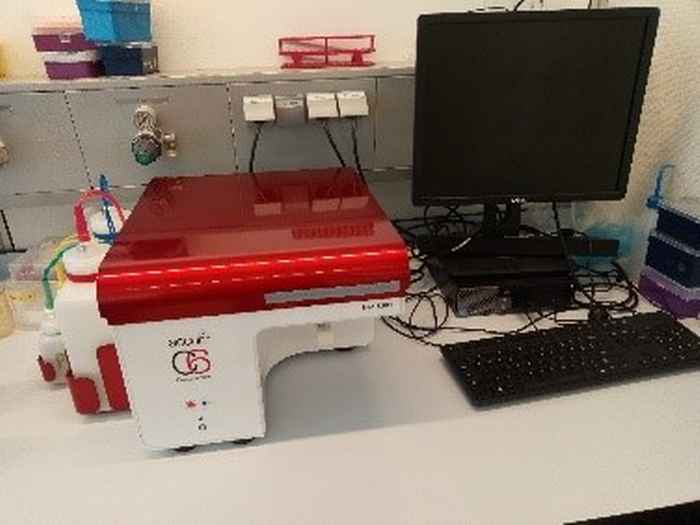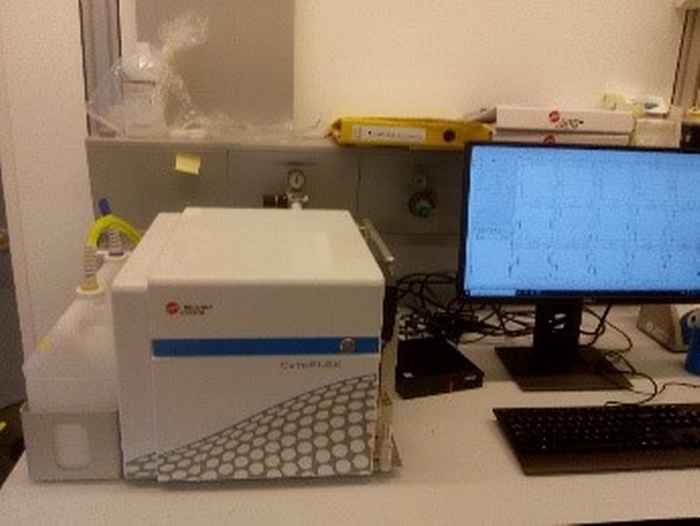Cell analysis and cell quantification

CASY TTT Cell counter
Our lab is equipped with a CASY TTT Cell counter. The CASY measures the conductivity between 2 electrodes separated by a defined pore. Cells are suspended in CASYton, a defined buffer solution. During measurement, cells passing through the pore generate an electrical pulse. The intensity of the signal directly correlates with the volume of the cell. Hence CASY detects the volume of each cell passing through the pore. This allows for the quantification of our algal cultures both in cell number as in biovolume.

Membrane Inlet Mass Spectrometry (MIMS)
In our laboratory we have a Hiden HPR-40 Membrane Inlet Mass spectrometer installed with a mass range of 200 amu (atomic mass unit) with a dissolved species probe. This allows for accurate measurements of a wide range of gasses either in gaseous or dissolved in liquid environments. Using stable isotopes specific changes in conditions applied can be quantified. The probe is positioned in a specialised cuvette.
Typical applications of the MIMS in our lab are:
- 13C-labeled bicarbonate or carbon dioxide uptake experiments to quantify rates of carbon fixation in cyanobacteria and algae.
- 18O2 uptake experiments to quantify oxidation or respiration rates during photosynthesis in cyanbacteria and algae.
-
Technical information
Specifications
- Hiden analytical HPR-40 Membrane mass spectrometer
- HAL201 RC mass spectrometer with Faraday/Multiplier detector
- Mass range 200 amu
- Dissolved species probe type 303416

Flow Cytometer
The Flow Cytometry is a laser-based, biophysical technology employed in cell counting, cell sorting, biomarker detection and protein engineering, by suspending cells in a stream of fluid and passing them by an electronic detection apparatus. It allows simultaneous multiparametric analysis of the physical and chemical characteristics of up to thousands of particles per second. In our studies Flow cytometry used to quantify bacteria (using dyes) and to distinguish an quantify different species of aquatic microorganisms (based on auto fluorescence).
In our lab we make use of a BD Accuri C6, a compact and user-friendly Flow cytometer. The system is equipped with a blue and red laser, two light scatter detectors, and four fluorescence detectors with optical filters optimized for the detection of most commercially available fluorochromes. It has a compact optical design, fixed alignment and preoptimized detector settings make the system easier to use.
-
Technical information
Technical Specifications (Accuri C6, BD Biosciences)
- Laser Excitation 488 nm and 640 nm
- Emission Detection: 4 colors, Standard filter set installed*:
- FL1 533/30 nm (eg, FITC/GFP)
- FL2 585/40 nm (eg, PE/PI)
- FL3 > 670 nm (eg, PerCP, PerCP-Cy5.5, PE-Cy™7)
- FL4 675/25 nm (eg, APC)
*other filter configurations are available - Minimum Detectable Particle Size 0.5 μm, Custom Core Diameter 5–40 μm

Beckmann Coulter Cytoflex Flow Cytometer
Our lab is equipped with a Beckmann Coulter Cytoflex Flow cytometry system. The Cytoflex is equipped with three excitation lasers: Violet (V -405 nm), Blue (B- 488 nm) and Red (R-638 nm). It comes with an extended set of filters of which 5 can be used at the same time. The following band pass filters are available in the Cytoflex: 450/45 nm, 525/40 nm, 585/42 nm, 610/20 nm, 660/10 nm, 690/50 nm, 712/25 nm, 780/60 nm.
It is suitable to measure particles as small as 80 nm and is therefore suited to measure algae, bacteria and viruses.
Contact information
Please contact us for more information: IBED-lab-science@uva.nl